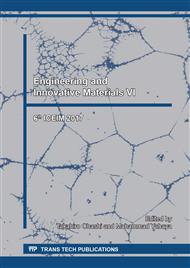p.89
p.94
p.99
p.104
p.109
p.114
p.120
p.127
p.132
Experimental Investigation of Bouncing-Back of Multidirectional CFRP Laminates during Ultrasonic Assisted Edge Trimming
Abstract:
Edge trimming process is needed for finishing CFRP components to the required accuracy and surface quality. The bouncing–back effect of CFRP components is very challenging owing to spring back of trimmed edge after cutting tool pass. Ultrasonic assisted machining (UAM) is an efficient method used to enhance the quality of CFRP parts due to the reduced contact time between the tool and workpiece. This paper experimentally investigates the effect of edge trimming variables on the cutting forces and the magnitude of the bouncing back. Diamond abrasive end mills were utilized during ultrasonic assisted edge trimming of CFRP. The processes variables include spindle speed, feed rate, radial depth of cut, fiber orientations, and up/down strategy. Statistical analysis was conducted to determine the most significant factor on performance characteristics. Regression equation was also developed to predict the value of bouncing back. The results showed that depth of cut and feed rate have a significant effect on bouncing back among the process variables.
Info:
Periodical:
Pages:
109-113
Citation:
Online since:
January 2018
Authors:
Keywords:
Price:
Сopyright:
© 2018 Trans Tech Publications Ltd. All Rights Reserved
Share:
Citation:


